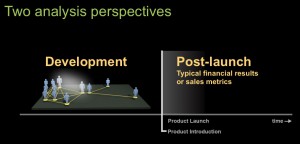A devastating zero model can guide your actions when deficiencies are discovered in projects. This concept may help you recover from new product development problems.
Suddenly aware
In one of my current projects, I had the impression that everything was satisfactory. The objectives were clear. We had support from the highest levels of management. It seemed that many of the individual contributors were engaged and working in a cohesive and harmonious manner, Then, I learned of one exception. There was a potential problem related to the promotional effort for the product.
In a communication with the project sponsor, I wrote that I had just learned of a potential problem and that I had requested more information.
In addition, I wrote the phrase “I am not involved with promotional efforts.”
It was then that I realized the cause of my mistake. An excuse of “not being involved” is inadequate.
When I became aware of the potential problem, my first tendency was to assign blame and demand accountability.
Fortunately, my thoughts shifted to options for recovery.
Two analysis perspectives
During my analysis, I discovered that I could improve my understanding of the situation using a mathematical model that I am proposing for new product development.
Typically, mathematical models associated with new product development projects are associated with financial results such as the return on investment (ROI) or total sales or relative growth. These types of analyses predict post-launch results.
Another type of mathematical model can be associated with development. It requires a pre-launch perspective.

Typically, mathematical models associated with new product development projects are associated with financial results such as the return on investment (ROI) or total sales or relative growth. These types of analyses are done post-launch.
Another type of mathematical model can be associated with development. It requires a pre-launch perspective.
Forecasting success
Prior to launch, there are many approaches to forecasting new product development success. Factors that may be used to predict success may include perceived qualities related to the following:
- Initial concept
- Refined concept (which is also known as a pivot)
- Business model
- Process
- Management
- Individual contributors
- Competition
The perceptions impact project decisions (such as go / kill / wait), project portfolio decisions, and business development decisions.
Development equations
Consider the following simplified equations that contain factors A to Z that contribute to the project value.
Value = f[A + B + C + … + X + Y + Z]
Value = f[A x B x C x … x X x Y x Z]
Examples of factors A to Z may include the contributions from individuals assigned to roles in functional groups such as engineering, testing, marketing, advertising, promotional efforts, and commercialization.
In the first equation, the hypothesis is that the contribution from one set of individuals adds to the value created by other individuals. Efforts are additive.
In the second equation, the same factors exist but the contribution factors are multiplied.
Implications
To determine which equation might provide better insights, I asked “What are the implications when the factor associated with ‘promotional efforts’ = 0 ?”
In the first equation, there will be a minor impact on the final value. In the second equation, when the promotional efforts factor has a value of zero, the total value will be zero.
The mistake I made
I realized that our project had system-level problems. The feedback regarding the promotional efforts was inadequate because the feedback was delayed. The lack of progress on promotional efforts was not sufficiently transparent.
I was in this situation because we out-sourced promotional efforts. We out-sourced promotional efforts because of precedents from prior projects.
In the next few hours, the seriousness of the problem became clearer. The project sponsor was furious. The sponsor signaled that they were considering termination of the project.
Two definitions of product
My insight occurred when I compared two of the definitions of product.
Product (noun)
- An object produced by the efforts of management and individual contributors. Typically, there is a process associated with developing a new product.
- In mathematics, a product is the result obtained by multiplying two or more factors.
Suddenly, I realized an alternative meaning of product development. The alternative meaning for product development is based on the second equation.
To improve product development, evaluate the factors that contribute to the project. Some can be improved. When the magnitude associated with one factor approaches zero, the value of the entire project will approach zero. Ensure that none of the factors has a value of zero. I am calling this a devastating zero.
Improving resilience
Enhancing resilience is one approach to improve the potential for new product development project success.
Resilience: the ability to adapt so that success can be achieved in cases of expected challenges and unexpected challenges.
Resilience is a desirable quality for any project.
The resilience of my project can be improved by any the following:
- Improving the appreciation for the quality of execution and teamwork necessary to achieve the objectives
- Additional training for the underperforming group. Assist them in developing a perspective regarding how their efforts impact project success
- Enhancing the capabilities of individual contributors to recognize situations today that will cause problems in the future
- Enhance the ability to detect problems through improved observations and orientation
- Improve the feedback throughout the system
- Increase the transparency of the work in progress
- Develop paths to recovery
Inadequate responses
When a deficiency is found, the other individual contributors should move beyond an “It is not my job” stance. All contributors should move beyond responses that include “assigning blame” or “demanding accountability.”
This simplified model predicts that a project can not be successful when one of the factors contributing to value equals zero.
To visually represent this, imagine several individual contributors in a boat. The boat has localized damage. Someone seated opposite from the damage yells “your side of the boat is sinking.”
Success Limiting Factors (SLFs)
This model builds on what I have previously described as Success Limiting Factors (SLFs). SLFs are items that impede new product development. Some SLFs have a deterministic nature. In some cases, there is a simple cause and effect relationship. In other cases, the interactions are more subtle.
In the extreme case, the project can be terminated because of perceived deficiencies in one factor.
Perception becomes reality
Before launch, all the factors tend to be qualified with words such as forecast, hypothesis, uncertainty, risk, and guess. In this context, perception influences decisions. Perception can be sufficient to terminate the project. Perception can become reality.
Developing products
I hope that the devastating zero model enables you to expand your product development repertoire. It requires that you enhance your capability to detect problems. You will benefit by expanding the way that you approach problems.
With the appropriate orientation, you will not have to relinquish success. You will be better equipped to hold on to success when a devastating zero is discovered.
The Devastating Zero Model of New Product Development [10 minutes, 9 MBytes]



